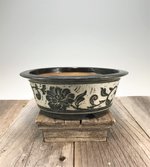penumbra
Imperial Masterpiece
When you make some pots and realize all of the time and material involved, come back and let us know if your views have changed. You would be lucky to get a couple dollars an hour. I don't.I'd like to support potters in this country, but I wasn't seeing a lot of what I wanted and also wasn't getting enough of a break in price to warrant their consideration
Consider making the pot. Which is several steps in and of itself that your time is not your own for days at a time concurrently.
Consider cleaning and prepping the pot and assuring a dry enough clay body to bisque fire without a pot explosion.
Consider your bisque fire. Mine averages 12 to 14 hours and can take longer.
Consider the glazing process which can be daunting and take from 3 to 6 layers of glaze allowing for each layer to glaze before applying another layer. I frequently sit up 'till 2:00 am glazing.
Consider final firing which in my case averages 11 to 12 hours firing time alone and does dot include stacking the kiln.
Consider waiting 12 to 24 hours for the kiln to cool enough so glaze and body don't crack or craze.
Consider the results. Which pieces might need re-firing, kiln shelf coatings ruined by glaze overruns, cleaning up feet or bottom of pots, grading into good enough to sell, good for own use, or good for target practice.
This is the easy way, using an electric kiln.
Consider now using a gas kiln, double firing time.
Consider wood firing, quadruple the firing time.
They is only one reason to make a pot and it has nothing to do with money. Very few people reach this level of expertise and/or business acuity.
I am not in any way bellyaching about being a potter. It is an act of creation and at its best an act of love. If you don't like my pot it changes nothing.





























